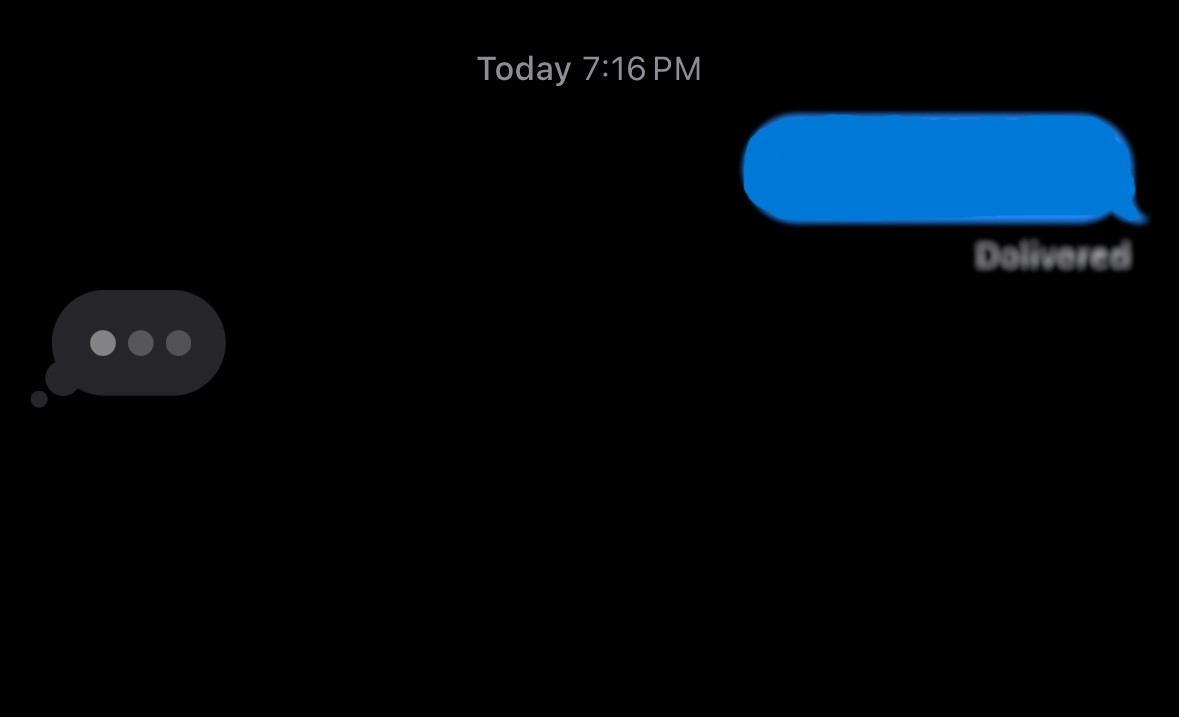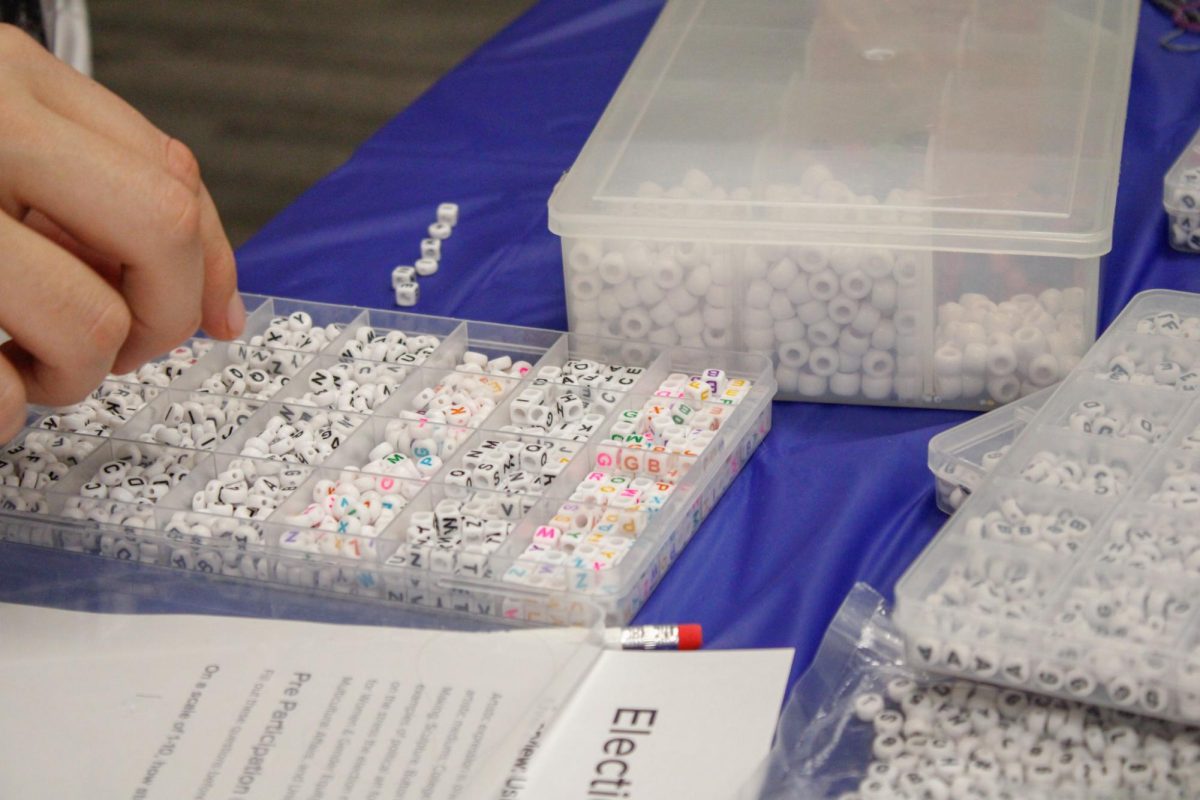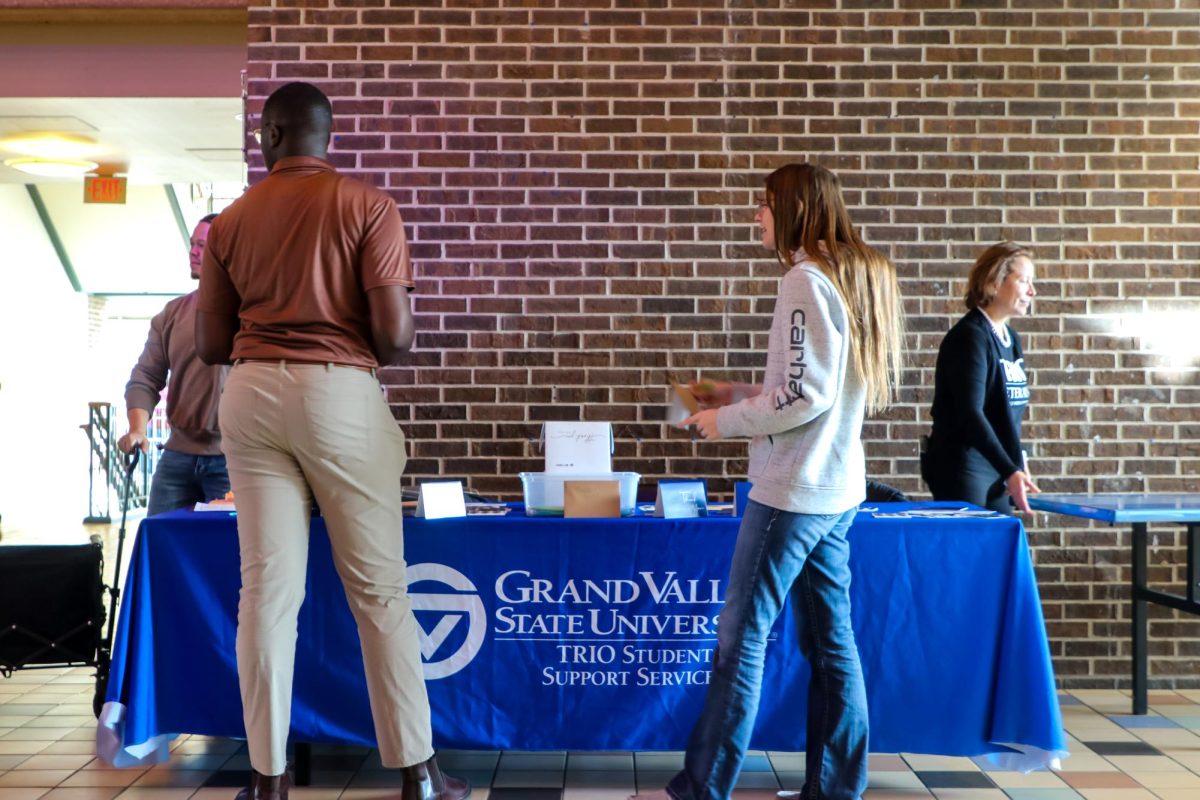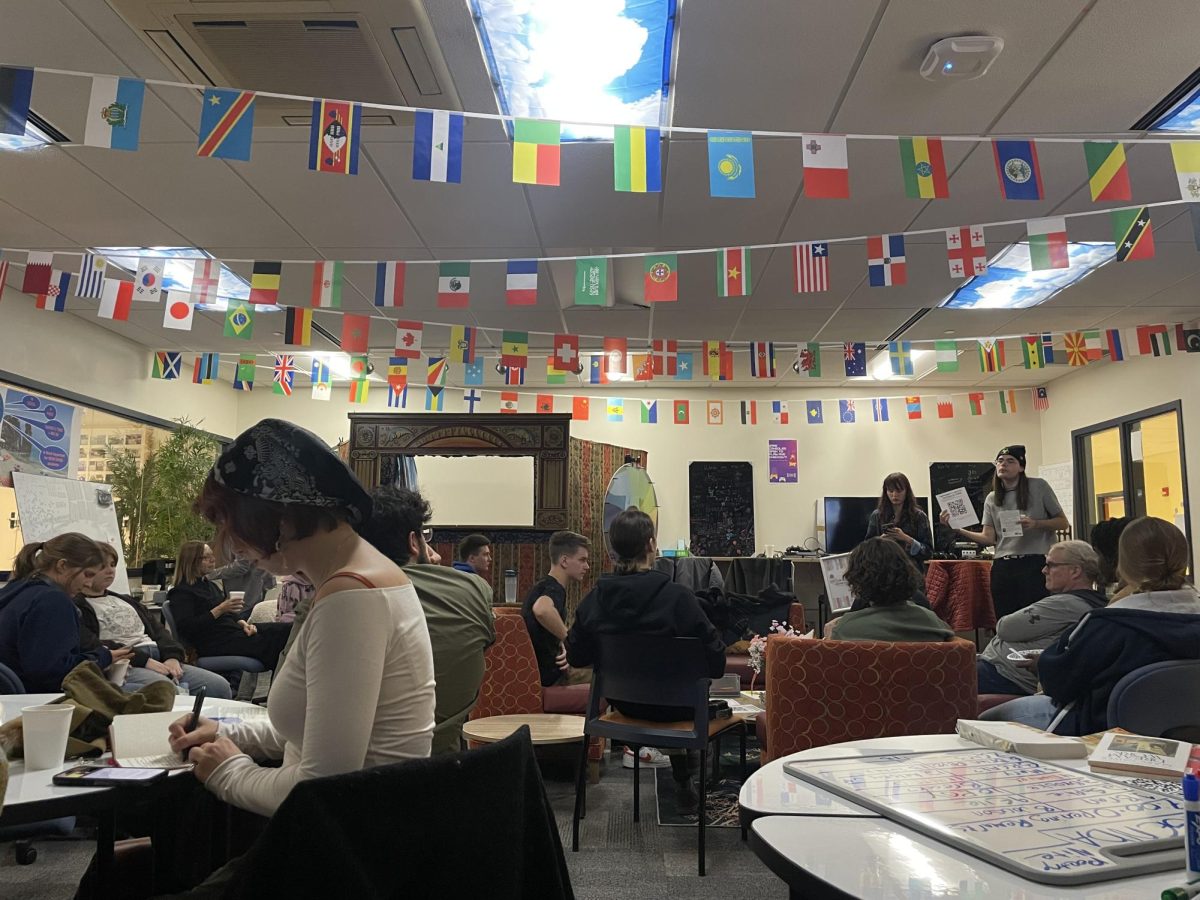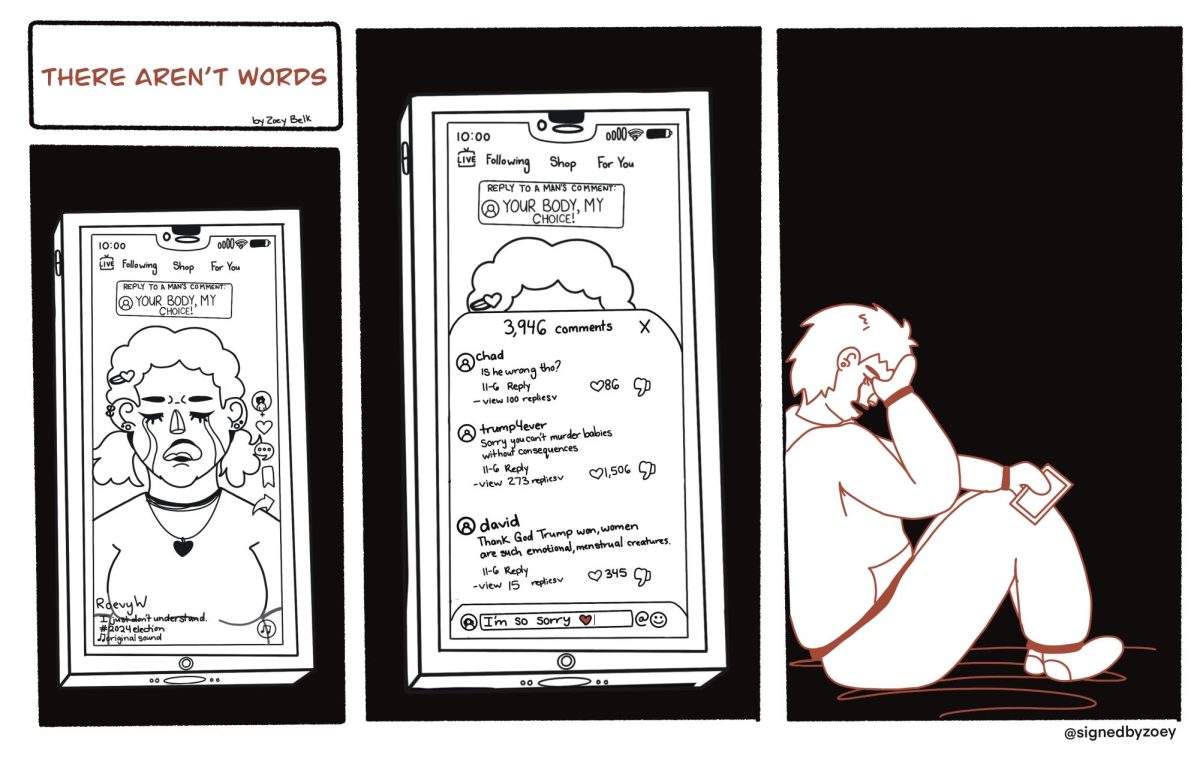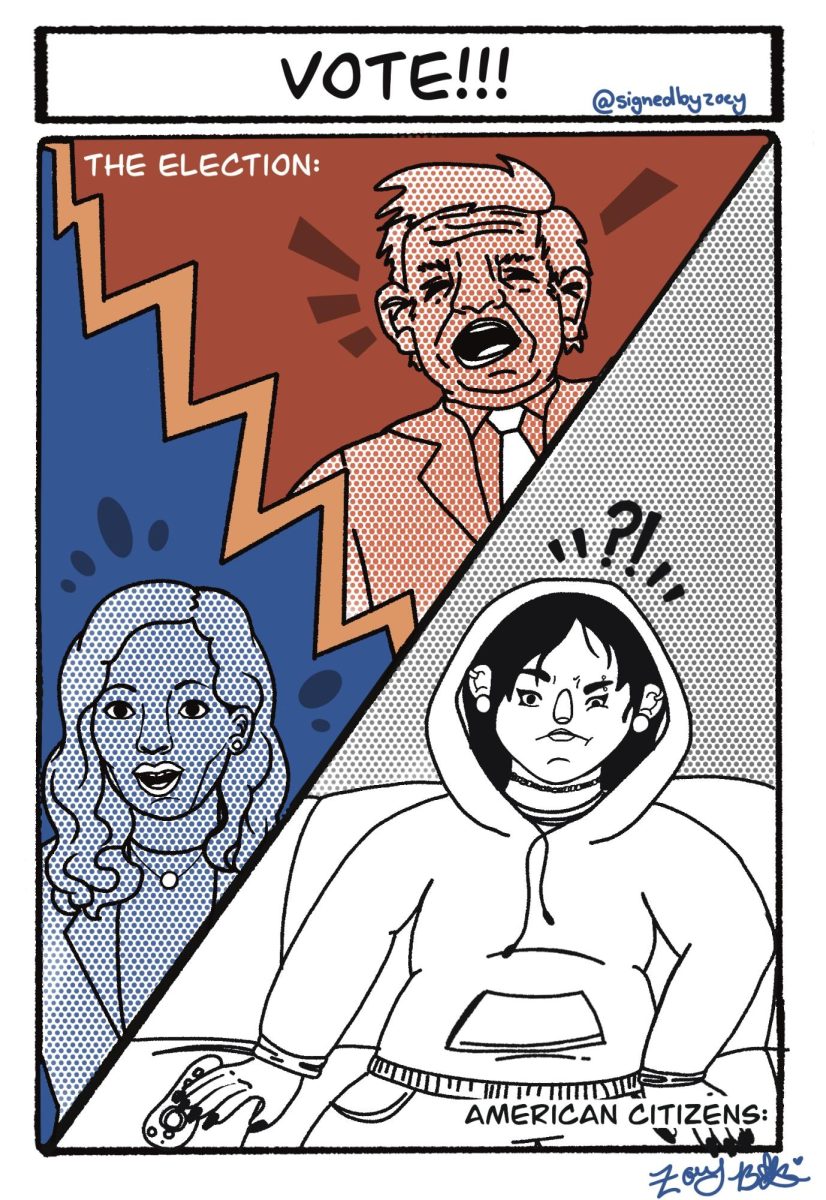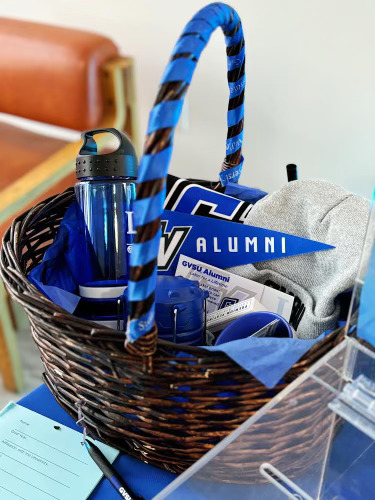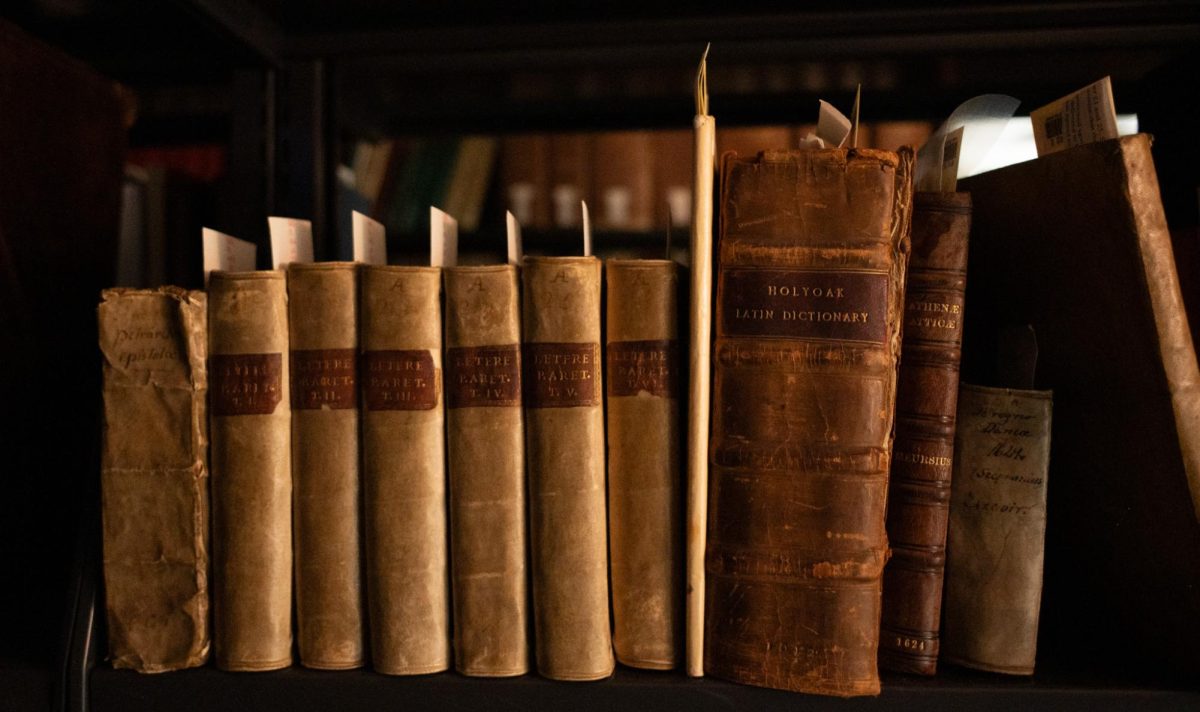Exclusive: Thomas Haas’ Lanthorn finale
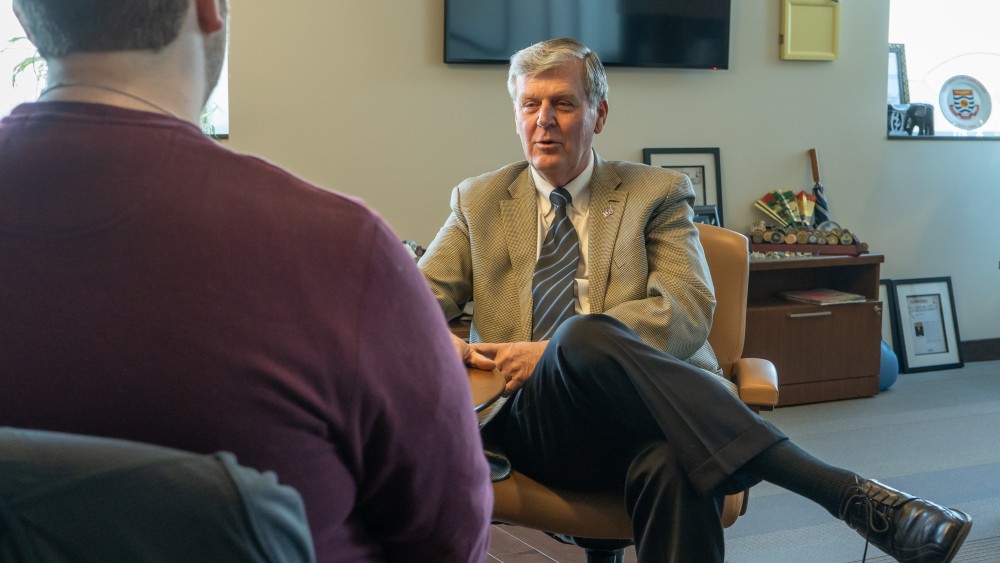
T.Haas Retirement Interview with Brady. Zumberge. 3/27/19 at 1 p.m. GVL / Ben Hunt
Apr 1, 2019
Editor’s note: With the impending retirement of Grand Valley State University’s President Thomas J. Haas – better known around campus as “T. Haas”, Lanthorn Editor-in-Chief Brady McAtamney, with help from Ben Hunt, Nick Moran and Amy McNeel, conducted the newspaper’s final exclusive interview with the iconic figure.
Brady McAtamney: Obviously this is your final year as president here. When did you officially decide that this would be the year?
Thomas Haas: Well, it was about a year ago when I had a conversation with the board chair and some other members and I looked ahead regarding the university, where it was and its history. It was coming up on its re-accreditation effort. We had a good, strategic plan in place to bring that closure and I looked at where my family dynamics were – my oldest son was going to be retiring from the Air Force, which he did a couple weeks ago after 20 years of service, and he and his wife just had a girl at the time. My other daughter and son-in-law live over in Chicago. They just had our first grandson, too. So we were looking at the dynamics of the family and the changes, and our health is great, thank goodness for that, and we decided with the university, in the shape it was in, was a good foundation to leave it for the next president. I asked the board if they would consider accepting my letter to retire, and one other son is in the Coast Guard and he’s going to be retiring here himself too, and he also mentioned that maybe we would want to be around a little. He has two little girls, not so little anymore, they are 11 and nine, but we were really enjoying every single day coming here. My wife has been a partner throughout the time that we’ve been here. And so we decided that with the university, I wanted to take it through it re-accreditation effort, and we did. We got a clean bill of health that just came out within the last couple weeks. That was one goal that I really wanted to see happen. And that particular report, by the way – I have been in the re-accreditation business in three of those six areas in the nation – I have never seen a report like that. That was as good of report feedback to us that I ever could have imagined. This is good for the students because it gives the elevation of the degree and the value of that degree as well, so that was good to see. And I’m still continuing to work on some other needs within the development world. We have an $85 million goal that we want to wrap up by 2020 and I want to continue to do some efforts there as well. And of course the day-to-day continues. I’m thrilled with the leadership I have on the President’s Cabinet. The board has been phenomenal in its support. So long answer to your question, it was – I think – the right time. With the history of the university, I’m number four; Zumberge was number one, being the founder; Lubbers was here for many, many years. He was an entrepreneurial president. Very, very good at what he did and developing friendships with the university – public-private partnership in many regards, and then Mark Murray came in. A phenomenal leader in his own way, within the state as a public institution he brought in a great skill set there. And my focus since day one, even in my inauguration speech, I said the North Star was going to be the student-centered nature of the university, the student successes is the North Star. All that taken into account, we believed and the board agreed with me that this is a good time for change for the leadership because of the circumstances we find ourselves in.
BM: What is your fondest GVSU athletics memory?
TH: There’s a lot of them. I enjoyed going to the first-ever championship football game. That was my first year and it was phenomenal. I walked into a very, very large hall and we had, what must have been 2,000 students, Lakers, parents, family members and friends rooting on the Lakers through the championship. And there, I’m walking and had been on the campus for a relatively short period of time, and to pick up on the nickname I received my first day right here at the (Cook Carillon Tower) with the student leaders in the transitions group along with Frank Foster, who was the student senate president at the time, they started chanting my name and I got chills. It was a remarkable expression of the mutual relationship and the respect that I had with our students and they with me. And probably the number of President’s Balls. Each one was unique in its own way and it was just wonderful to once again see the students and how they embrace who we are as an institution. So the athletic piece is one, but many of those student President Balls have been very, very special as well. And probably the last one is most recently. So go from one national championship with football to the most recent ones, we’re down in Pittsburgh, where Marcia and I decided to spend the day. We flew down early in the morning, were able to match up with the men’s cross country, and they won the national championship. It was muddy, rainy and cold, but we were so thrilled to see the men’s team come across the line, and then followed up with the women’s who did the same thing. That was thrilling and to see the other embraces with the national championship teams that we experienced with soccer and the indoor/outdoor track and cross country. All phenomenal. And what we started with the football team, is they would come to my home – the whole team including the coaches and those supporting – and we would have a dinner in their honor. So, we had 110 people in my home that first year, and then we wrapped it up with two national championship teams at our home with men’s and women’s cross country.
BM: So going back, you kind of talked about your first few months here on campus. Describe to me your first day of being on campus as president.
TH: It was in August of ’06, Monday, and it was a beautiful day. We had gone into the office about 7:30 (a.m.) and my wife and my daughter at the time who was still with us, she went on for a time in the Navy and now is living with her husband over in Chicago as I mentioned before with our first-ever grandson to go with the five granddaughters we already have. So we were here in the office, and at about 10 (a.m.) was on the calendar with Rachel, my assistant and Frank Foster and a few other members of the student senate would take me on a tour of the campus through the eyes of the students. Of course, I had been taken on a tour before. So, I said sure and he said ‘but we’re going to stop by the Carillon,’ and I did and we met up with probably 210 or so transitions students and at that point in time, this was 10 in the morning, I said, ‘It’s great to be here. I look forward to meeting many of you.’ And one of the women there asked, ‘What can we call you?’ and I said well, ‘President Haas, Dr. Haas, call me Tom informally, that’s fine.’ And then she said, ‘How about T. Haas?’ and the students started chanting. And then there was a news reporter following us from the Grand Rapids Press and that afternoon, in the review of my first day, it said ‘Students Welcome T. Haas to Campus.’ So it stuck here in campus, it stuck then into the community, and even now my wife is calling me T. Haas. And then we followed up the rest of the day with meetings with faculty, some of my staff members and had lunch with, I think it was the football team. We just went for lunch over at Fresh. And then later on that afternoon, after some more meetings, I decided to go watch the women’s soccer team practice and enjoyed watching them participate as well. And it was a glorious first day.
BM: That sounds pretty great to me. So you mentioned eating over at Fresh and that leads perfectly into my next question. What’s your favorite on-campus meal to get?
TH: Well, pizza. I like pizza, no doubt about it.
BM: Me too.
TH: I’ll do a salad and a pizza. We have gone over many times to the Connection – that was new and I was able to support the building of that. But over in Fresh, usually it’s pizza and salad. And then I do like Qdoba – that’s been a good place to stop. And at least twice a year, I get to go behind the carving station to carve either ham or turkey – that’s one of my traditions so I do that as well.
BM: Very nice. So how have you grown both as a person and as a president since you took over here.
TH: We continue to grow as leaders. We learn so much from those people around you. I’ve learned a lot from our students. I’ve listened to their needs, and it has changed over the years as well. We’ve been becoming a more and more diverse campus. Inclusion and Equity was one of my focal points early on with the hire of Jane Arnold, who was the first VP and now Jesse Bernall who is the second. That was very important. So I’ve learned much in the space of inclusion and equity. Really the point on my work as a Coast Guard officer, my time in the service, (was) how important it is to achieve a mission. I continued in learning and growing as leaders must. One of the important aspects, I think, of a leader is to tie in their service component to the mission and to ensure that they continue to grow as a leader. So, I learned a lot about the students. And to give another good example is our focus on sustainability. I learned so much more from the students and how passionate they are and continue to be about sustainability. I am too – from the Coast Guard background I have – with Environmental Health Sciences. That is one of my areas of emphasis. We need to protect our globe for the generations ahead. That’s going to be more and more important for me now that I’m a grandfather, too. So, I think that’s another area that I’ve grown to appreciate. And then I think I’ve grown to continue to have the patience to effect the changes that we need to ensure that students get the best learning environment that they can have. I’ve learned a lot about student safety on campus, Title IX and all of that; that’s critically important and as a leader, you need to understand that those dynamics might change, the laws might change. At the end of the day, you want to make sure that you have a safe, secure environment for our students, and everyone that is working here and visiting here as well. I continue to really grow and understand strategic thinking and planning because the academy is changing the way we deliver the programming we offer. When you think about the online programs, the hybrid programs and those types of things, we really need to understand that we have to ensure that the students are growing within the use of technology. So I like the high-tech, high-touch feel and I’m growing a greater appreciation for that. Also, understanding that it’s not just the content, but the ability to use the content that helps student succeed. The whole notion of understanding the enterprise is where I’d like to continue my growth. And probably equally important is learning what the needs are within the community and how we, as an institution, need to grow and adapt in the development of the talent. Whether it be in the health professions, education, business or whatever discipline we’re teaching here, I continue to learn and it always comes to this point. We need to drive the relevance of this institution toward the needs of the students and their success. I’ve learned a lot about leadership throughout the years, but I continue to learn from those who are around me.
BM: Perfect, perfect. Bringing it back to just a few months ago, what was your reaction or feeling toward issuing five consecutive snow days?
TH: Let me put it this way: I don’t like to close school. We’re Michiganders at the end of the day, so I just don’t like closing it. But we could not justify putting anyone in harm’s way. That particular episode was once in a lifetime, if not once every hundred years, or more. But it was the right thing to do. I was asked the other day about closing down school and not putting on President’s Ball, and, well, I missed it. It was a lot of work by so many people, so many students who put their passion into that particular activity. At the end of the day, my ultimate responsibility as a fiduciary to student safety and health is to make sure that we’ve protected them to the best of our abilities. That was just an unusual circumstance, but I know that we did the right thing.
BM: Now, this one is a little heavy, a little tough, but what kind of legacy do you hope to leave at GVSU?
TH: You know, one’s legacy is once one leaves, and I do think in ten years from now that the alumni who were here during my time viewed their time as a great investment in their future; that they have discovered what I call “the habits of heart and mind” to be successful. We have created while we’re here a learning environment that was relevant to them and their futures. That legacy can be built upon the fact that we continue to be attuned to our own institutional integrity to our mission, and that we believe in that mission, in shaping student lives, professions and societies, and that we’re true to that mission. That we deliver the promises on that mission. And that during my time here, 13 years, we grew numerically from about 22,000 to 25,000. But we grew numerically in the number of graduated from about 4,000 to 5,600 year over year. We grew about 8 percent in terms of incoming numbers, so to speak. The outcomes, the delivery on the students with a degree increased by 40 percent. So I think that if the legacy is anything, it’s that I was always attuned to the North Star of student success and student centrality. I think that that will be seen hopefully with our alumni as they go into their professions and into their work life. But also into their service lives and into their communities and across the globe.
BM: Now, this next one is kind of a two-part question. First, what’s your favorite selfie you’ve ever taken with a student or with yourself or really any selfie that you’ve ever taken? And then what’s the most uncomfortable selfie you’ve ever taken. Have you ever had a selfie with a student that was kind of odd or uncomfortable for you?
TH: For one thing, I’ve probably taken 10,000 or more through the years. We do this Toast with T. Haas now (for) graduation – we do a lot of selfies there as well. You know, I’ve never said no to a student request. But most recently, this was kind of a fun way that a student asked me. He runs up to me and he says, “Hey, T. Haas! Are you available for a selfie?” I’ve never been asked if I was available for a selfie before. I thought that was pretty unique! So then we took the selfie and I thought that was kind of a neat way to demonstrate the mutual respect that the students have for me, but that I have for our students. One time wasn’t uncomfortable, but it was to my colleagues. I was walking across campus to a meeting and a student stopped – and we were running a touch late, and I don’t like to be late – but a group of students stopped and said, “Hey, T. Haas, we need a selfie.” My colleagues were antsy about going, but I said to wait a minute. I wasn’t uncomfortable, but I thought my colleagues said, “What is Tom doing? Well, Tom’s doing what Tom does!”
BM: And that’s taking selfies.
TM: We engage with the students. It’s really that relationship with engagement. If at the end of the day, the student has a good memory about this institution because I’m available for a smile, then isn’t that great? It’s that mutual respect. It’s priceless. And it’s all driven by students. That’s the other part that I need to reemphasize. It wasn’t me, per se, but it was me saying “sure.” One of the things about leadership that I find is that you should show up, so I’ll show up to chemistry class and teach freshman chem. Or I’ll go to football, basketball or to the performing arts center, or go see some of the research work that we do with the students and faculty members as well. But you show up. As a leader at an institution like Grand Valley, one cherishes the opportunity to show up and to see what our students are doing day in and day out. Early on in my time here, I would show up in the start of the winter semester and I would spend a night on campus. I would engage with students, maybe go out and have pizza at Fresh and spend the night in one of the residence halls, too. Those are some of the great memories. Those are the types of things that a leader has to understand: that they do represent the university, and to be visible and explore what the students are all involved with. At the end of the day, I’m an educator. That’s what my role is.
BM: Absolutely. That’s a really awesome, little tradition that has been built with those selfies.
TH: The other part of the selfies is now I’m getting selfies requested by parents, by faculty members and members in the community as I’m going out and about. We had the parents event where I invite parents of students for dinner when we were over in Chicago. I had a line of students and parents who wanted to get a selfie. Every one has been special. I can’t say that there was one that stands out more than any because they all do, and I mean that from my heart. They all do. It’s because it was important to that student that they asked and had the confidence to say, “Hey, are you available for a selfie?” Absolutely, I’m available for a selfie.
BM: Always. Even if you’re running late to a meeting. Now, what would you consider to be your greatest achievement at GVSU?
TH: I could do that in a couple of ways. From a physical standpoint, I think creating the health campus in downtown Grand Rapids. Before, we had one building, and now we have literally a campus that has grown since probably 2010. I think from a physical standpoint that is a testimony to the vision we have here at the institution to build the talent and the space that’s important to west Michigan and the health professions and nursing, including some of the efforts in engineering down there. I think that particular physical demonstration of supporting the regional needs and the healthcare industry is one that I’m very, very proud of. Then if I look here on the campus, I’m going to view the buildings that we have created, the learning environments whether it be the Mary Idema Pew Library, to the efforts with Kindschi Hall and some of the others, the rehab of the football stadium, the lacrosse and the outdoor track facilities, the club sports area, all that. All the investments made. The one area that I’m really thrilled with is that we all focused on the LEEDs certification of the additional learning spaces that we have here. The Leadership in Engineering and Environmental Design and so I’m really, really pleased with the efforts that our staff put forward. James Moyer in particular, but others supporting him. James now is retired but to create the environmental design for the future, I think that is something I’m very proud of. And then probably on a more intimate level, I think our focus in on inclusion and equity with the hiring of our (vice presidents) in that space before an institution like us to have a vice president on the staff and working at that and I know that is critically important to student success. So lots of things from a physical standpoint and then from a more cultural need here for us was student success and probably, if you tie it all together, that we have become a more relevant institution.
BM: This one’s a bit unique, but it was actually requested by some students for me to ask. If you were a professional wrestler or professional athlete, what would your walk-in song be?
TH: My walk-in song… okay, that’s a good one. Let’s see… what would it be? Now I say this because it’s one of my favorite songs, it’s meaningful to me and it doesn’t work with a professional wrestler or athlete, but What A Wonderful World is one… my wife and I enjoy that. It would be kind of an interesting paradox, you walk in with a wonderful world, but it truly is. When I think about the adventure my wife and I have had, we’ve been married for over 45 years right now, the places that we’ve gone, the places we’ve seen, here at the university with some of the activity, some of the travels with our international partners, that is one of those songs that means a lot to me. But if you wanted to roll it up, We Are The Champions. I like Queen, so I would put it that way. One from a personal standpoint with wonderful world, and then with Queen.
BM: I think those are both excellent choices, both excellent songs as well. Now, you’ll be going from being the president of the university to teaching for the next, what was it, year or so?
TH: Well I’m going to take a little time off. I’ve never taken a sabbatical. I’ve been teaching for 42 years and I’ve never had a sabbatical so I’ll take a little time off and then we’ll come back and get involved in the classroom a little bit.
BM: Are you worried that your reputation as the president might make it difficult or distract your incoming students that you’ll be teaching?
TH: I don’t think so. As I continue to teach now, I go into a freshman chemistry class, organic chemistry class, that’s never been a distraction here. I think it’s been embraced by the students a lot because at the end of the class period there’s usually a few selfies of course, but in fact I heard from an alum over in Chicago, she said ‘I was in your freshman chemistry class and I think you had some balloons.’ I was doing some structures, she remembered that from 12 years ago. Now she’s a PT over in Chicago. I don’t think so, but I have a funny story for you.
BM: Let’s hear it.
TH: I’m here, I’m going into freshman chemistry, it was one of the larger lecture halls, and after I lectured in the freshman chem, one student came up and goes ‘are you related to our new president? Because you have the same last name.’ I said ‘I know him really well.’ We both had fun with that. They’ve demonstrated, to go with your question, the confidence that the student had to come up and just engage. I say just the opposite. I think the students, when I’m in the classroom with them, will recognize that I had some leadership role here but at the end of the day I’m an educator helping them in their pursuits of a degree.
BM: Do you have anything else that you’d like to say? Do you have anything you’d like to touch on that we haven’t gotten into yet?
TH: Yeah, I think so. One of the areas of great satisfaction has been within the development space and that is developing friends for the university, whether it be through helping folks invest here in a new facility or invest in scholarships, invest in somehow into Grand Valley State University and I think that that has been a wonderful display of confidence. When I met Bill Seidman, for instance, he’s reputed to be the founder along with others, he had the vision of the university just like this. I think that we continue to see now those individuals continue to invest and now, what I’m saying some of the alumni that are coming, out of the probably the 180,000 alumni I’ve probably shaken hands with half of them. What I see with a great deal of pleasure is people wanting to come give the same advantage to students that are here or are going to be here in the coming years and that investment, to me, validates our mission. And I think that that is pretty special note to end up on. So many people come here because they choose to be here. They could choose to go other places. We have a remarkable student body. From the standpoint of who they are individually and collectively, they are talented academically and in regards to the talents they bring to us. And so they choose us. So the donors and the investors are choosing us as well because we’re giving a good return on that investment, good value. And that’s what Grand Valley is all about. It gives us a good value, a good education, a good step forward and hopefully the habits of success that they are investing here to get are seeing a good return here as well.












